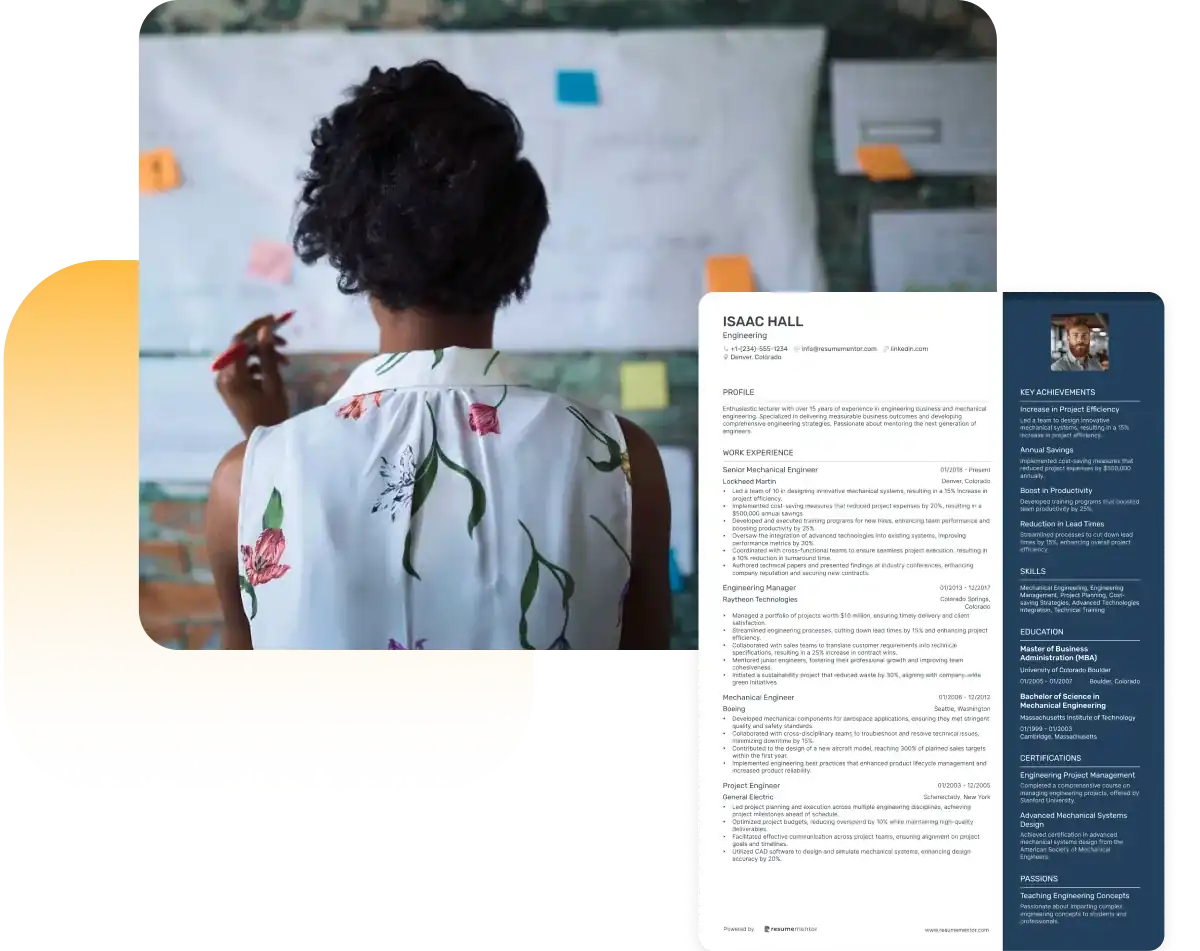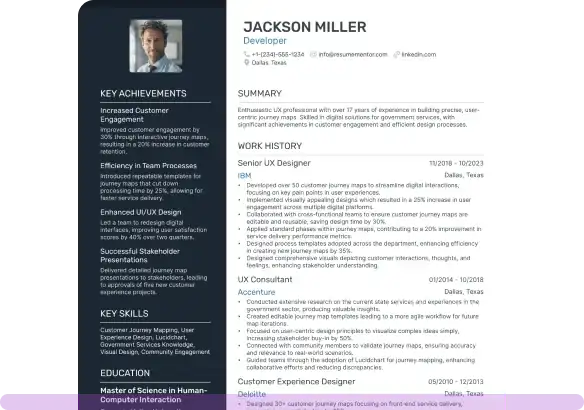How and When to List References on a Resume

May 16, 2025
|
12 min read
Learn when and how to include references on your resume to boost credibility and job prospects.
Including references on your resume can be confusing. Should you list them up front or wait until later in the hiring process? And how many should you include?
If you’re unsure how to write a resume that’s clear and effective, it’s easy to overlook references or treat them as an afterthought. But when you tailor your resume and choose the right references, they can add credibility and strengthen your application.
This guide covers everything you need to know about resume references—who to list, how to format them, and when to share them—so they work in your favor.
Key takeaways
- Select two to three professional references who can confidently discuss your work skills.
- Clearly format your references, including name, job title, company, phone, and email.
- Always request permission before listing someone as a reference.
- Use a separate document if space is tight, noting "References available upon request" on your resume.
- Adjust your references list based on your career level—entry-level or executive roles have different expectations.
Why include references on a resume?
References offer employers insight beyond your resume's listed skills and experience. They validate your professional achievements, character, and reliability.
In competitive job markets or industries emphasizing trust (like healthcare, education, or law), strong professional references are crucial. A compelling reference can sway a hiring manager's decision, especially when deciding between similarly qualified candidates.
PRO TIP
Proactively including references signals you're prepared and confident in your professional relationships, setting a positive tone for the hiring process.
Additionally, references can highlight specific aspects of your professional background that may not be evident through your resume alone. For example, a former boss might say how you handled difficult tasks, did well in stressful situations, or helped a project succeed.
These anecdotal insights often resonate strongly with hiring managers, providing valuable context to your listed achievements.
Is your resume good enough?
Drop your resume here or choose a file.
PDF & DOCX only. Max 2MB file size.
Now that you understand why references matter, the next step is knowing how many to include based on your career stage.
Determining the number of references
The appropriate number of references can vary based on your career level and the job you’re applying for:
- Entry-level candidates: Typically provide two to three professional references. If limited professional contacts are available, consider adding personal references such as professors, mentors, or community leaders.
- Mid-level professionals: Usually include three to four employment references—ideally former supervisors, managers, or close colleagues who know your recent work.
- Executive positions: Often provide four to five strong references from previous leadership roles, with a clear reference description of your professional relationship.
It can also be beneficial to align your references specifically with the role or industry you’re targeting. For example, people who want to lead teams might be more likely to include references who have seen them manage teams well or handle big tasks.
Similarly, those applying for highly specialized technical roles might choose references capable of clearly describing their technical skills and expertise. Matching your references with the position’s expectations ensures they add maximum value to your application.
Of course, numbers aren’t everything—choosing the right individuals for your reference list is just as important.
Selecting the right references
Always choose professional references who know your capabilities and can discuss specific achievements.
Ideal candidates for your reference list include:
- Former supervisors or managers who have closely observed your work.
- Colleagues who have collaborated on significant projects.
- Clients or business contacts familiar with your professional abilities.
Avoid selecting family or personal friends unless they have relevant professional insights. The right mix of references ensures employers receive a comprehensive understanding of your skills and experiences.
It’s also crucial to include references who can comment on your soft skills and interpersonal abilities. Modern workplaces value teamwork, flexibility, and communication skills. Coworkers or supervisors who have seen your interactions in work environments can best confirm these qualities.
By choosing references who can talk about both your soft and hard skills, you show a complete, appealing picture of yourself as a candidate.
Once you’ve identified who to include, the next step is making sure they’re both willing and prepared to speak on your behalf.
Requesting permission from references
Before listing people as references, ask them if they want to be mentioned. This is important for staying professional and networking well.
Follow these best practices:
- Reach out early in the application process to secure their willingness and ensure they are prepared.
- Clearly outline the role you're applying for, the company's details, and why you're interested.
- Confirm their current contact information (phone and email).
- Inform your reference contacts when employers might reach out during the hiring process.
- Always express sincere gratitude—send a brief "thank you" message to maintain positive professional relationships.
This practice ensures your reference list remains reliable and prepared, and it enhances your professional image among potential employers.
Additionally, when contacting references, consider providing them with relevant details or talking points about your recent achievements or projects. If you give a short summary or update about your work achievements, references can remember specific examples.
This makes their talks with potential employers more focused and effective.
Here’s a resume summary example with a testimonial:
And now, a cover letter example with a testimonial:
After getting their permission, timing becomes critical—knowing when and how to share your references can improve your chances with employers.
How and when to share references
Knowing when and how to share your reference information with employers can enhance your professionalism and streamline the hiring process.
- Initial application: Generally, avoid attaching references unless explicitly requested. This maintains your privacy and protects your references' time.
- Interview phase: Provide references later in the hiring process—typically after the first or second interview. At this stage, the employer is genuinely considering you, making references timely and impactful.
When you do share references:
- Prepare your reference list as a clearly formatted, separate document in chronological order or by relevance.
Each entry should clearly state:
- Reference name
- Reference position
- Reference company
- Reference phone number
- Reference email address
- Reference description (optional): Clarifying the professional relationship and timeframe.
Clearly labeled and organized references reinforce your professional approach and demonstrate attention to detail.
Another key consideration when sharing your references is timing and coordination. Inform references immediately once you’ve provided their contact details to potential employers. Let your references know when you expect to call or email them. This will help them be ready for calls or emails.
This proactive communication not only reflects your professionalism but also helps maintain strong professional relationships for the long term.
See the example below:
Jane Smith
Marketing Director
Brightwave Agency
Phone: (555) 123-4567
Email: jane.smith@brightwave.com
Relationship: Former manager at Brightwave (2019–2022)
Even with well-chosen references, a few missteps can weaken your application. Here’s what to avoid.
Common mistakes to avoid with resume references
Avoid these common pitfalls when preparing your references:
- Listing too many references: Employers typically expect two to five quality references.
- Using outdated information: Always verify the accuracy of your references' current contact details.
- Personal references without professional relevance: Stick primarily to professional contacts unless explicitly requested otherwise.
- Poor formatting: Inconsistent fonts, layout, or typographical errors can distract employers. Keep it professional, neat, and easy to navigate.
- Assuming employers will always contact your references: Not every employer will contact your references, but always be prepared and clearly indicate availability.
If you’d prefer not to include references on your resume at all, there are several smart alternatives worth considering.
Alternatives to listing references directly on your resume
If you're limited by space or prefer discretion, consider these alternatives:
- "References Available Upon Request": A concise, professional statement that keeps your resume tidy.
- Separate reference sheet: Attach a well-formatted separate page, offered later in the hiring process.
- LinkedIn profile: Include recommendations or testimonials directly on your professional social media profile.
- Professional testimonials in summary: Incorporate a brief, impactful testimonial directly in your resume summary or cover letter.
These alternatives provide flexibility without sacrificing credibility or professionalism.
Conclusion
Including references thoughtfully can significantly strengthen your resume and help you stand out to potential employers. Strategically select two to three quality references who can effectively validate your professional strengths and character. Ensure references are clearly formatted, accurate, and prepared.
If unsure whether to include them upfront, utilize alternatives such as a separate reference document or "available upon request" statement. Whether you're a new candidate or looking for a top job, taking care of your references helps you look professional and ready for the hiring process.
To make it easier, use our resume building tool to organize and format your resume and references with confidence.
Related Articles

Continue Reading
Check more recommended readings to get the job of your dreams.
Resume
Resources
Tools
© 2025. All rights reserved.
Made with love by people who care.
